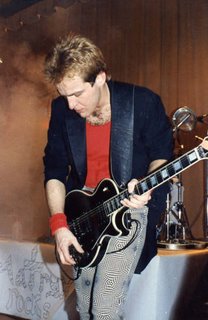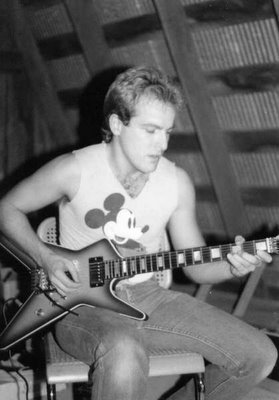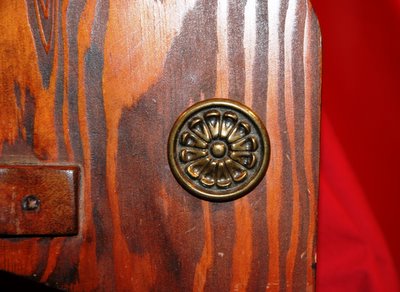Thursday, November 03, 2005
Spandex #2

More spandex. Check out the placement of my wireless guitar transmitter (below my left hand.) I attached to the back of my guitar so it would not get in the way when I threw the guitar up into the air. Once while playing "warm-up act" for the band Styrper I nearly bounced this guitar off the ceiling at Memorial Auditorium and caught it perfectly. Other nights were not so graceful and I would end up catching the guitar after it bounced off of my head or groin (ouch.) I have never, contrary to popular belief, been knocked unconscious while attempting to catch my guitar on the way down. I never ever dropped it, I did miss a few notes doing it though...
Barn Party B&W Photo early 1980's

This shot was taken at a barn party in the early 80's. I remember this gig as being one of the best concerts I had ever played. I think there were maybe twenty people there. I had forgotten my strap and had to play seated the entire time. The guitar was a Dean "ML" I got from Dean Zalinsky personally. This guitar went on to become Dime Bag Darrell's (of Pantera) main axe. I guess I have made more of a mark in rock & roll history than I realize. No wait they shot Dime Bag during concert didnt' they? I did not have anything to do with rock & roll history...
Bill Sutherland onstage with "Spinal Tap" aka Matrix/Bride

This photograph never fails to make me laugh aloud. It looks so much like the legendary rock band "Spinal Tap" one of my biggest influences - second only to "THE OUTERLOOP BAND! (who are actually more like my biggest influenza.) This shot was actually taken one Easter morning at my fathers church (NOT!) Thanks to Scott H. for digging these pictures out of the vault and dusting them off for me.
Tuesday, October 25, 2005
The Revelator acoustic.
 I built this guitar in the 7th grade - that would have been around 1973 I guess. I did not know how to bend wood so I came up with a design that would allow me to construct the guitar using all angle cuts. Unfortunately I knew nothing of bridge and saddle placement at the time so it is way out of intonation. The sound hole was cut big enough to allow me to install a speaker I got out of a television set that I found in a dump were I used to ride my bike. It severed nicely as pickup but was removed later to use in some other "experiment" I was doing at the time. The knob is actually a cabinet door pull I also found at the dump and provided the guitar with an non-functional yet elegant faux-volume knob! While the other kids were struggling to make a wall sconce for their mom I was busy trying to start my own line of guitars - "The Revelator!" It bears more than passing resemblance to an electric guitar I built about 20 years later - and with perfect intonation I might add!
I built this guitar in the 7th grade - that would have been around 1973 I guess. I did not know how to bend wood so I came up with a design that would allow me to construct the guitar using all angle cuts. Unfortunately I knew nothing of bridge and saddle placement at the time so it is way out of intonation. The sound hole was cut big enough to allow me to install a speaker I got out of a television set that I found in a dump were I used to ride my bike. It severed nicely as pickup but was removed later to use in some other "experiment" I was doing at the time. The knob is actually a cabinet door pull I also found at the dump and provided the guitar with an non-functional yet elegant faux-volume knob! While the other kids were struggling to make a wall sconce for their mom I was busy trying to start my own line of guitars - "The Revelator!" It bears more than passing resemblance to an electric guitar I built about 20 years later - and with perfect intonation I might add! 
 I built this electric guitar in 1995 or so. Considering the life it has led on the road it is in remakably good condition. The body is Mahogany with a Zebrawood top (Zebrawood has a tone similar to ash/maple) The neck is made of Walnut and has an unfinished Maple fretboard. The guitar is very dark sounding but thanks to the mixture of woods chosen it also has a nice pronounced top end and a very defined mid range punch. It has been a good guitar guitar and has never let me down on stage or in the studio. Thanks to the trick wiring of the pickups - Al DiMeola bridge (DiMarzio) and a PAF Pro in the neck (also DiMarzio) it is capable of providing me with both "Fender Stratish" tones and "Gibsonesque Les Paul" sounds as well. The inverted Pre-CBS style strat headstock gives me a little extra sustain and I like the tension it gives to the strings - the little "E" string is shorter than the lower "E" string - normally it is the other way around but this set up is really more appropriate for the string tensions I think. I believe it is one of the little things that made Jimi's tone sound like it did. I think the slight similarities between this guitar and the one I built in 7th grade are kind of funny. Zebrawood-like grain, custom knob, custom wiring, somethings never change...
I built this electric guitar in 1995 or so. Considering the life it has led on the road it is in remakably good condition. The body is Mahogany with a Zebrawood top (Zebrawood has a tone similar to ash/maple) The neck is made of Walnut and has an unfinished Maple fretboard. The guitar is very dark sounding but thanks to the mixture of woods chosen it also has a nice pronounced top end and a very defined mid range punch. It has been a good guitar guitar and has never let me down on stage or in the studio. Thanks to the trick wiring of the pickups - Al DiMeola bridge (DiMarzio) and a PAF Pro in the neck (also DiMarzio) it is capable of providing me with both "Fender Stratish" tones and "Gibsonesque Les Paul" sounds as well. The inverted Pre-CBS style strat headstock gives me a little extra sustain and I like the tension it gives to the strings - the little "E" string is shorter than the lower "E" string - normally it is the other way around but this set up is really more appropriate for the string tensions I think. I believe it is one of the little things that made Jimi's tone sound like it did. I think the slight similarities between this guitar and the one I built in 7th grade are kind of funny. Zebrawood-like grain, custom knob, custom wiring, somethings never change... 
Zebrawood guitar closeup of controls
 A nice closeup of the Rosewood knob, threeway pickup selector switch, tone switch and coil-tap switch. The tone switch is an idea I stole from an old Gretsch guitar I used to have. It is a three way switch with the middle position wired open (no tone shaping) the up position adds a .22 microfarad cap for a nice throaty tone shape and the down position setting of the swith incorporates a.44 microfard cap that is very dark and creamy when activated. It is easy to wire and allows me to quicly and accurately hit the tone position I need. This is real handy when I am playing the E-bow!
A nice closeup of the Rosewood knob, threeway pickup selector switch, tone switch and coil-tap switch. The tone switch is an idea I stole from an old Gretsch guitar I used to have. It is a three way switch with the middle position wired open (no tone shaping) the up position adds a .22 microfarad cap for a nice throaty tone shape and the down position setting of the swith incorporates a.44 microfard cap that is very dark and creamy when activated. It is easy to wire and allows me to quicly and accurately hit the tone position I need. This is real handy when I am playing the E-bow! 
Zebrawood Guitar Front perspective
 I built this guitar around 1995 or so. It has a Mahogany body with Zebrawood top. The neck is made of Walnut with a unfinished Maple fretboard. The knobs are made out of Rosewood. The controls are as follows: Two Volume knobs, a threeway pickup selector switch, coil-tap switch and an idea I stole from an old Gretsch guitar I had - a tone switch!
I built this guitar around 1995 or so. It has a Mahogany body with Zebrawood top. The neck is made of Walnut with a unfinished Maple fretboard. The knobs are made out of Rosewood. The controls are as follows: Two Volume knobs, a threeway pickup selector switch, coil-tap switch and an idea I stole from an old Gretsch guitar I had - a tone switch! 
Thursday, August 04, 2005

An early version of the Big Tone Generator. Probably around V.12 I think. Currently I am running on V.22. Rack components are the same but wired a little differently. Both pedal baoards have been built and modified with quick connect "ELCO" connectors. The speakers have changed - I just could not get everything in my Jeep with the big speakers! You gotta dig that vocal side looper pedal board - velcro baby! I wish my stage was this clean - in heaven everything will be wireless. I will put some updated Big Tone Generator pictures up soon. Everything is basically the same except the vocal side pedal board is finished (matches guitar side footboard) and the speakers are different.


Front shot of Acoustic Rig Big Tone Generator. From top to bottom. Top rack: Monster Power AC Conditioner - filters out all kinds of noise from the AC line plus you can turn everything off and on with just one switch. ADA Digitizer 4 Delay - my main delay repeat hold unit. It is set to very precise time intervals and then I build longer loops from there. TC Electronic M2000 for guitar reverbs TC Electronic M2000 for vocal reverbs. Samson mixing board - very basic just treble and bass (which I leave flat) and volume control. All of my tone shaping is done via the TC Electronic 2240 Parametric EQ units. TC Electronic 1210 Spatial Expander. Top TC Electronic 2240 channel 1 parametric for Trance Audio Lens pickup, TC Electronic 2240 channel 2 for the Sunrise magnetic field pickup. Bottom TC Electronic 2240 parametric EQ channel 1 for Harp Guitar, electric Hamster Cage, Musical saw and Theremin. TC Electronic 2240 parametric EQ channel 2 for vocal microphone. Insert panel for quick cable hook ups (and tear downs). Lower Rack: Furman power conditioner (with lights on, SWEET!) Sabine stereo EQ for house speakers. Mesa Boogie Strategy 500 tube power amp - 250 watts per side of pure beautiful tube tone. Weighs a ton but no matter how many times I try to get away from the tubes I always go back, it just sounds right!


A close up of the guitar side looping footboard. From top to bottom: Upper deck left side ADA FS-2 - controls bypass and repeat hold functions of the ADA Digitizer 4 delay unit. Upper deck right side - ADA DS-4 allows choice of 1 of 4 delay presets. Middle deck - Boomerang looper pedal. Lower deck from left to right: Off/On for TC Electronics 1210 / Bypass for ADA Digitizer 4 / Repeat hold for ADA Digitizer 4 / Bypass for guitar M2000 / Bypass for vocal M2000. I made the lower deck out of an aluminum door threshhold I found at Home Depot - looks very nice I think.


TACKY! This is the original working version of the Vocal side looping footboard. From top to bottom: Blue Pedal upper left corner Boss Harmonizer - used only for doubling my voice, all of my harmonies are done live. Tan pedal middle center Boss EQ used originally to recreate a nasally AM radio kind of sound I have recently started using it as a boost to shore up the softer whispery vocals that need help. Grey pedal right top DOD direct box to break the 1/4" plug down to an XLR balanced send to the board. Lower left pedal FS-5U tap tempo pedal. By tapping this in time with the music I can set the delay repeat time to be in sync with the song. Big green pedal Line 6 delay. This is what I use to stack hatmonies and build ambient rhythms. The buttons tend to want to stick so you have to watch it. I have found that wiping the swithes down with a little guitar polish does wonders - the silicone I suppose. Also I carry my stage shoes in a little leather bag and do not put them on until I am ready to play that way I do not accidentally get dirt and "crud" down into the pedal switches plus I have an excellent excuse to carry around a little leather bag! Lower right creme pedal Boss Delay. Lower right dark red pedal Octaver for guitar for when low just is'nt low enough. I ran with this version until I was sure what pedals and the order of them I was going to use.

Wednesday, July 27, 2005

Solid Koa wood back and sides - beautiful, I hear it is on the endangered wood list now. Koa is from Hawaii and really seems to come alive when you tune down a little bit. No wonder the Hawaiian players discovered the "Slack Key" method of guitar playing! Hard to see but you might notice the center line of the back matches the Rossette design around the soundhole. Classy. Dig that Koa wood grain, sometimes I look at it and weep. I tend to do that with J-lo's backside as well.


The off set saddles make for a better intonated instrument and also give greater clarity and definition between the wound and unwound strings. I have the treble side wired seperate from the bass side so i can play in stereo. This effect coupled together with the banjo tuners glissing notes up and down makes for some very interesting textures and really exagerates the suggestion of two "different" people playing at the same time. I guess there are really, me and my split personality...


A close up of the Banjo tuners with the two (1 black, 1 gold) stop points. The stop points allow a musician to tune up to a pitch, lock the point and then tune down to a specific pitch and lock its point. Now, in theory, you can gliss back and forth between the two pitches very quickly and dare I say "accurately"? Also shown are the Takamine "HAP" tuners. The hole in the middle of the "HAP" tuner allows the player to "unlock" the cap stan of the tuner and adjust its height up or down and by doing so affect the tension of individual strings. Sad to say but Takamine no longer offers these tuners. I don't think many guitarists realized what they did. Lucky for me I bought up a small "stash" before they were all gone. heeheehee...

Wednesday, July 06, 2005

A beautiful shot of the harp guitar. My wife loves the aesthetic of this guitar and when company is coming over she often asks me to place it in our dining room so everyone can see it. Sometimes I just sit and stare at it. Sometimes when my wife is gone I dress it up in her naughty underthings and sit and stare at it. Okay, maybe I just made that last bit up. Maybe...


In the sound hole you can see the magnetic field pickup that captures the string energy of the guitar side of the harp guitar. If you look at the left side of the pickup you can see an appenditure coming off it and pointing down into the guitar, this the "arm" of a choir microphone meant to reference the acoustic cavity of the instrument. I have since moved on to a Sunrise magnetic field pickup (the best) and the Trance Amulet Lens system (also the best). At the time this picture was taken there were 2) Magnetic Field pickups on the sub bass side, 6) hex-a-phonic pickups on the bridge of the guitar side, 1) magnetic field pickup in the sound hole of the guitar side, and 1) Choir microphone inside of the guitar. You think I am serious about nailing the guitars tone? You better believe it!











